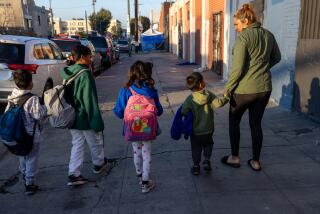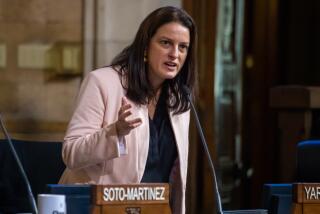Los Angeles Takes a Big Lead : Is First in Area to OK Funds for AIDS Outreach Efforts
Mayor Tom Bradley and the Los Angeles City Council, with its unanimous vote appropriating emergency funds for special AIDS education and outreach service programs, are providing welcome leadership in controlling the AIDS epidemic.
The council is the first government body in Southern California to establish outreach with bleach and condoms to intravenous drug users, the group that poses the greatest threat of expanding the epidemic. The condoms serve as a reminder of the dangers of sexual transmission of AIDS. The bleach, effective in cleaning needles, can reduce the risk of transmission when needles are shared. Community-based groups will implement the program, distributing 60,000 AIDS prevention kits bought with $25,000 from the city.
Council members also voted $30,000 for an outreach education program aimed at minority populations to increase their awareness of the efficacy of early intervention with persons infected with the human immunodeficiency virus (HIV) that causes AIDS. A new city study found that HIV infection is progressing to full-blown AIDS more rapidly among poor people, including ethnic minorities, because they are not receiving early intervention care as are the more affluent. Hundreds are being denied life-extending therapies through ignorance or inadequate public services.
Los Angeles County Supervisors earlier had rejected a recommendation from their own AIDS Commission to undertake the condom and bleach distribution. There has been similar resistance in Orange and San Diego counties. Federal funding has underwritten two demonstration outreach programs in the area, however. Horizontes targets Latino intravenous drug users in San Diego, and the AIDS Research and Education Project based at Cal State Long Beach works with drug users in that city. Both projects have reported positive results. Funding is being sought to perpetuate Horizontes when its three-year federal funding runs out in August. The Long Beach program, in its second year, already has reported evidence of behavior change among the more than 1,000 persons interviewed.
Critics have argued that bleach distribution could be seen as official approval of drug use, and that condom distribution could encourage promiscuity and exaggerated confidence in the limited protection it provides. Analysis of the programs in place, however, has found no such negative consequences. Most public-health officials remain convinced that it is an effective way to reach drug-dependent persons and educate them on the dangers of AIDS while opening the door to rehabilitation. In fact, some public-health officials believe the effort would be even more effective if it included a needle-exchange program.
HIV infection rates remain relatively low among intravenous drug users in Southern California, ranging from 5% to 8%. By comparison, New York’s rate is an appalling 50% to 60%. But New York’s experience could be repeated in Southern California unless outreach programs to high-risk populations prove more effective, according to public-health officials.
The commitment of Bradley and the council responds appropriately to that risk. And it responds to the study by Dave Johnson, city AIDS coordinator, charting the inadequacy of early treatment programs among the poor, including minority populations. The study has inspired not only the emergency funding but also plans to appropriate an additional $500,000 for the fiscal year commencing July 1. Unfortunately, no similar response has been forthcoming from the county governments of the region which are, in fact, the responsible public-health agencies and should be taking the lead. That makes the city’s leadership all the more important, all the more welcome.
More to Read
Sign up for Essential California
The most important California stories and recommendations in your inbox every morning.
You may occasionally receive promotional content from the Los Angeles Times.










